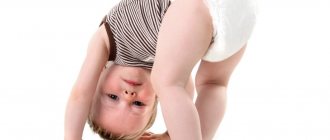The easiest way to put a baby to sleep is to rock him in your arms, this way you not only put the baby to sleep, but also calm him down and make up for the lack of maternal warmth. However, over time, this procedure becomes labor-intensive, since the baby grows and becomes very heavy, and then the question arises: how to wean a child from motion sickness? There is no definite answer to this, but regardless of the choice of methodology, weaning from the usual ritual should be carried out gradually so as not to traumatize the child’s psyche.
Should you rock your baby to sleep before bed?
At first, being carried in your arms helps the baby adapt to extrauterine life. He got used to limited space, warmth, and the beating of his mother’s heart. It is these conditions that parents create when, soothingly, they press her to her chest and rock her slightly, as if she were walking naturally.
It needs to be installed correctly. Running and sudden movements do not put you to sleep, but, on the contrary, excite you. It is recommended to walk slowly, but it is better to sit, turning smoothly from side to side and swaying slightly. At this time, you need to say something very quietly and tenderly or sing a lullaby.
Attention!
Experts advise stopping motion sickness by 4 months. If you do not prepare for the weaning process, children will scream and demand to be “taken in your arms.” It is difficult to put down an excited manipulator.
The benefits and harms of hand rocking
At an early age, in the arms of the parents, the baby feels protected and calms down faster. This stimulates psychophysiological development. But this is not the only benefit of motion sickness. This procedure:
- Relaxes and normalizes the functioning of internal organs.
- Prepares the baby's vestibular apparatus for future walking - when the child is raised and lowered, he is in weightlessness for some time. Overly nervous children in this state begin to grasp for air.
- Smooth movements inhibit the nervous system, muscle tension decreases.
The first 2-3 months after birth, internal organs are still at the stage of formation. The intestines are populated with beneficial flora, the loops are straightened, which is why babies often develop colic. The warmth of the mother's body soothes painful spasms.
Interesting!
It has been experimentally proven that with close contact with their parents, children grow up more self-confident and successful in life.
But motion sickness also has its downsides. Parents falling asleep may squeeze the baby too tightly and put him in the wrong position. In a mild case, this will lead to regurgitation; in a severe case, it will lead to disruption of the position of the cervical vertebrae, and sometimes to injury. Too sudden movements cause dizziness and negatively affect the function of the vestibular apparatus.
In addition, adults often try to put the child to bed when he is not ready to sleep, which causes rejection and hysterics at the sight of the bed. If you do not get rid of a bad habit in time, a psychological dependence develops - you cannot fall asleep on your own. It's exhausting for the family. Parents who don't get enough sleep have poor health and conflicts in the family.
Pros and cons of rocking babies under one year old in your arms
Children who spend very little time with their mother then become withdrawn, aggressive and cannot stand up for themselves. To prevent this from happening, frequent contact between the baby and the nurse is necessary. However, when the baby grows up, this becomes difficult to do, so you need to wean the baby off your hands as quickly as possible.
Children say! - Anya, go collect the toys! - Don't wake up the sleeping deer!
Motion sickness in the first few months of a baby’s life has positive qualities:
- the baby is always happy and fed;
- light rocking movements calm the baby and put him to sleep;
- the baby is distracted from pain if he is bothered by colic;
- the baby forgets about emotional overstimulation;
- Smooth movements help the baby understand that he is loved.
Therefore, we can say that the first time after birth, motion sickness of infants is one of the elements of care.
Among the disadvantages of this procedure, one can note the need to be constantly present with the child. There is no opportunity to do household chores, in addition, in the future it can be very difficult to wean a baby from motion sickness without hysterics and consequences.
For parents! If you refuse to wean your baby from motion sickness before 12 months, you will have to carry out this ritual until he is 2-2.5 years old, waiting until the child outgrows this habit.
Otherwise, you can study our following tips and watch the topical video.
Why does a child get used to motion sickness?
Obligatory parental hugs before bedtime turn into a ritual over time. But there are other circumstances that should be paid attention to. Dr. Komarovsky identifies the following reasons:
- Parents do not adhere to a constant daily routine. Of course, the baby does not know when to fall asleep and when to stay awake.
- Sleep should be replaced by active wakefulness. It is difficult to get those who are not yet tired to sleep.
- Digestive problems caused by colic, illness, introduction of new foods. A negative impact is caused by changes in meal times and the nursing mother’s consumption of foods that are poorly absorbed by the developing body.
The baby is prevented from falling asleep by discomfort: tight or too loose swaddling, uncomfortable clothing, light, loud noises. They feel smaller in your arms, the warmth of the parent’s body calms you down for a short time, but as soon as you put them back in the crib, the sleep will be interrupted.
How to wean a child from motion sickness
To teach your baby to fall asleep on his own, you need to develop a new sleep ritual. This could be reading books, singing lullabies, walking on the balcony (or in the yard) in a stroller for 10-15 minutes, bathing, or laying on a fitball. We need to come up with something alternative to rocking in our arms that is just as pleasant and soothing.
Attention!
As long as the child is unwell, motion sickness should be continued. Regardless of what causes discomfort - fever, colic, teething - the period of education is postponed until the condition is completely restored.
In the crib
To relax your muscles, you can get a massage before going to bed. Movements used:
- smooth stroking;
- gentle palm pressure;
- light touches that massage therapists call “ether”.
The child receives all the necessary sensations associated with protection: warmth, relaxation and support. At first, activity can be limited by loose swaddling.
It is not for nothing that in folklore there are many lullabies, monotonous, sung in a quiet voice. You need to learn 2-3 and sing before bed, wondering how to wean your child from rocking in your arms. There is no need to replace them by playing various melodies, even the most “soporific” ones for adult ears. For older children, you can already pick up a recording of the sounds of nature - for example, the rustling of leaves.
Nowadays you can purchase special children's lamps with a certain flickering frequency. Dim reflections slowly moving along the walls quickly lull even the most curious and active ones to sleep.
On hands
This method is for the most naughty. If after all the “ritual” actions the whims continue, you can take the baby by the hand, or stroke the back while sitting next to the crib. He can’t calm down - you can pick him up, hug him, but under no circumstances rock him. I calmed down - they returned me back.
Fairy tales, songs, stroking - only in the crib; in my arms - my mother’s warmth. Older children, already from 6 months, quickly understand that “communication” is more pleasant than limited and short-term contact with parental warmth. In addition, he is not excluded - the hand of mom or dad is at full disposal.
You shouldn’t hope that after 2-3 nights getting ready will take 15 minutes and you can move on to your own affairs. You will have to sit near the crib for several nights - some children give their parents sleepless time during the week.
Attention!
There is no need to scold, much less shout or spank the child. This will only excite him and make him cry. Of course, many babies, tired of crying, fall asleep. But such a vacation will not be complete and healthy.
Putting a child to sleep without motion sickness - dream or reality?
10.10.2014
78
Do you know what the second most common problem after falling asleep on the chest is when it comes to putting babies to sleep? That's right, sleep without motion sickness. This question often arises among mothers whose babies are bottle-fed, and instead of the habit of falling asleep with the breast, these babies have developed the habit of falling asleep after prolonged rocking, and in extreme cases, riding in a car or in a stroller. Naturally, by the time your little bundle of happiness has already gained a weight of 6-7 kg, the process becomes labor-intensive, and by the year when the baby’s weight approaches 10 kg it is already dangerous for the mother’s health.
Why do babies need motion sickness?
Yes, yes, they often require it! If a mother suddenly decides to save a couple of hundred calories and try to sleep in other ways, she often faces fierce resistance from her child. The fact is that such children most often fall asleep through rocking for a long time and now they simply don’t know that it is possible to fall asleep in another way.
“A habit has been given to us from above - it is a substitute for happiness,” said A.S. Pushkin. And he was right - having a comfort zone in an already well-known situation, we rarely dare to just change the established rules. And children are especially sensitive to changes in the “rules of the game” and resist it as actively as they can.
The baby’s lack of experience and other tools in the arsenal of falling asleep also adds to the general protest - how can you hammer a nail without a hammer (sorry - fall asleep without motion sickness)? And this is where mom’s work begins, where she explains and shows alternative options: if there is no hammer, take a stone, try a heavy brick, etc.
How to put your baby to sleep without motion sickness
First of all, it is important to tune in and decide not to download. Often this step is more difficult for the mother than others - she, like the baby, simply cannot imagine how he will fall asleep differently! Here it is worth remembering two wonderful phrases of Dr. Komarovsky: “The child cannot help but sleep” and “The baby needs a healthy mother” - it’s hard to argue, you will agree.
The next step is to make sure that, in addition to rocking to sleep, you have other elements of the bedtime ritual by which the child understands that next it will be time to sleep - a book, a lullaby, changing into pajamas are good options. Offer your baby a full-fledged relaxing massage, feed him (not until he falls asleep), pat him on the back - your efforts should be aimed at making the baby relax.
Be patient and persistent. If you decide to change something, you should not retreat. If you rush between rocking and laying down without rocking, you will only confuse the child - he will not understand at all what you want from him.
Offer options that do not involve rocking: sit next to him, pat him on the back, hiss, sing a song, put your favorite bunny down together.
If you have been trying for a long time (at least an hour), then arrange a “reboot” - leave the room for 20-30 minutes, get distracted, repeat the ritual in its shortened format and start again: repetition and your consistency will help the baby learn the new regime faster.
Don't be afraid of the baby's crying - you are not mocking the baby or forcing him to do something he cannot do. Protest when changing the usual order is normal, and you should see things in perspective: your baby will not cry endlessly, in a few days everything will be over, but if you leave everything as it is, you risk earning an intervertebral hernia (and then you will definitely stop pumping, but at what cost!) – who will benefit from this?
Start your efforts with evening bedtime - at this time the baby is most ready for sleep, his body naturally produces sleep hormones and, thus, the work on mastering a new skill will be as productive as possible. In principle, it is more difficult to fall asleep during the daytime, and even more so without the support of a familiar instrument.
Comprehensive work on baby's sleep
THE PACKAGE IS SOUND
individual support from a specialist
More details
If you need help
Are you hesitant to tackle such a delicate issue yourself? You can count on help and support! In fact, a mother often wants specific step-by-step instructions and answers to questions precisely in her difficult situation - this is where my work comes in. If you need to lean on someone's shoulder, get a clear plan and make sure that you are not experimenting on your baby, but doing productive work, sign up for an individual consultation and together, we will definitely fix the situation!
Did you like the article? Rate:
Votes: 109
Advice from Dr. Komarovsky
A well-known pediatrician believes that motion sickness does not cause any harm to a child’s health. But it causes inconvenience to parents, so it is advisable to wean it on time - from 4 to 6 months. If the baby starts screaming, asking to be held, you first need to make sure that he is not experiencing discomfort - he is fed, watered, clothes are dry, the sleeping place is comfortable, the air is humid - he can breathe easily.
Evgeniy Olegovich convincingly emphasizes that parents who decided to wean their child from motion sickness before bed without a “sleep ritual”, but decided to tolerate the whims for several days, are not heartless. They are simply determined to get their way. This attitude justifies itself, especially when the child is already more than 1-1.5 years old. After 3-5 days, the whole family will sleep peacefully, and parents will get an extra 2-3 hours of free time.
Features of the process that you need to prepare for in advance
Before you start refusing to rock your child in your arms, you need to take into account some of the specifics of this period. To avoid serious problems, the following points must be taken into account:
- Even if the first time the child reacted normally to the fact that he was not rocked to sleep before bed, this does not mean at all that the next day he will not throw a tantrum about this. Real adaptation to independence takes at least 1-2 weeks. Only after this period has passed can it be determined whether the parents are on the right path or whether they will have to wait a while before giving up their “handles.”
- When working with children about a year old, everything is complicated by the fact that they are already capable of conscious actions. Some toddlers deliberately throw hysterics, demanding to be rocked in their arms. Here you can count on a positive result only if the parents show firmness.
- A period of illness is not the best time to start the process. At such moments, children should feel maternal support. But here you need to be careful. Some “prodigies” understand that the mother is unable to resist the sick child, and they literally begin to behave like they are sick.
The individual characteristics of children also need to be taken into account. In general, in the process of weaning a toddler from motion sickness, you need to pay increased attention to the baby. Sometimes, even if the child does not outwardly react in any way to the fact that the mother is “distant,” this can negatively affect his sleep or appetite.











